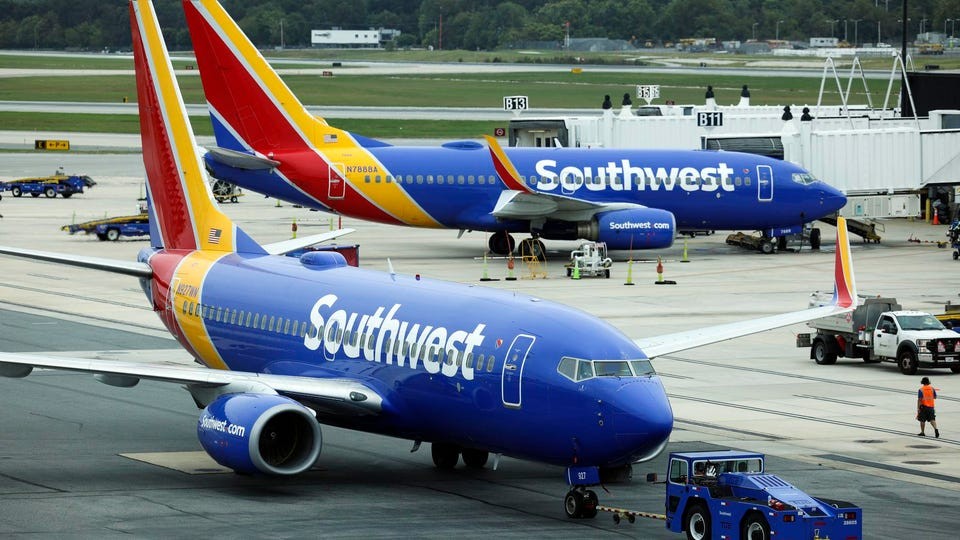Top 10 Largest Airlines in the US by Passengers
| Summary |
The U.S. airline industry is shaped by a combination of major carriers that excel in terms of passenger volume, destinations, and revenue. These airlines have a long-standing presence and offer extensive domestic and international networks. Some of the major airlines are American Airlines, Delta Air Lines, and United Airlines. These airlines usually provide various classes of service, a wide selection of destinations, loyalty programs, and are affiliated with major global airline alliances.
Low-cost carriers, such as Southwest Airlines and JetBlue Airways, typically provide more affordable fares and fewer amenities compared to legacy carriers. For example, Southwest is renowned for its distinctive boarding procedure and complimentary checked baggage policy.
Some airlines, like Spirit Airlines and Frontier Airlines, offer lower base fares but often have additional fees for things like seat selection, onboard meals, and luggage. These airlines are perfect for travelers on a budget and usually focus on shorter flights.
Alaska Airlines and Hawaiian Airlines have extensive route networks within and from these unique states, connecting remote locations with major cities and providing links to the continental U.S. and international destinations.
In 2024, we have compiled a list of the top 10 largest airlines in the United States, focusing on the number of passengers they have carried. Every category of airline has a vital role to play in the extensive transportation network of the country, guaranteeing that practically any location can be reached by air within and from the United States. Consumers have the freedom to select from a diverse array of service levels, pricing options, and destinations in this expansive ecosystem.
 |
| Top 10 Largest Airlines in The US By Passengers Carried Today |
Benefits of The Large Airlines in The US
Extensive Network and Connectivity
Large U.S. airlines operate flights to a vast number of destinations both domestically and internationally. This extensive network connectivity allows them to serve as global connectors, offering passengers more travel options and easier connections to destinations around the world.
Economies of Scale
The size of these airlines allows them to achieve economies of scale, meaning they can operate more efficiently by spreading costs over a larger number of operations. This can lead to more competitive ticket prices and cost-effective operations, benefiting consumers and the airline.
Loyalty Programs
Major airlines offer comprehensive frequent flyer programs that reward customer loyalty with benefits such as free flights, upgrades, and other perks. These programs are designed to retain customers and encourage repeat business, creating a strong incentive for travelers to choose a particular airline.
Financial Stability
Generally, larger airlines have greater financial resources, which help them weather economic downturns better than smaller carriers. This stability is crucial in the volatile aviation industry, where economic cycles can dramatically affect operational viability.
Ability to Offer Premium Services
With diverse fleets and significant resources, large airlines are able to offer a range of services from low-cost economy seats to luxurious first-class suites. This diversity attracts a wide range of customers, from budget travelers to those seeking luxury experiences.
Job Creation and Economic Impact
Major airlines are significant employers and contribute heavily to the economy through direct employment, as well as by stimulating tourism and commerce in the regions they serve.
Top 10 Largest Airlines in The US By Passengers Carried
1. American Airlines
 |
| American Airlines |
Main Hub: Dallas/Fort Worth International Airport
Passengers Annually: American Airlines leads with a significant passenger volume, transporting approximately 165.68 million passengers annually.
Seats and Flights: Operating a large fleet, American Airlines ensures a broad seating capacity across its extensive network. In Q1 2023, American Airlines managed to transport 48.2 million passengers with an average yield of 21.35 cents per flown mile. The total capacity measured in available seat miles (ASM) was 65.0 billion for this period.
With a staggering number of 165.68 million passengers annually, American Airlines leads as the largest airline in terms of passenger volume. American Airlines, headquartered at Dallas/Fort Worth International Airport, is known for its extensive global network covering almost 350 destinations. Despite financial challenges, including a high debt level peaking at $54 billion in 2021, the airline has been focusing on reducing its liabilities and improving profitability. It recorded a small net profit of $10 million in the first quarter of 2023, marking a significant financial recovery.
2. Delta Airlines
 |
| Delta Airlines |
Main Hub: Hartsfield-Jackson Atlanta International Airport
Passengers Annually: Delta Airlines carries more than 185 million passengers annually, making it one of the largest airlines in terms of passenger volume.
Seats and Flights: Delta operates a large number of flights, supporting its high passenger count. In the first quarter of 2023, Delta's ASM was reported as 61.3 billion, with revenue passenger miles (RPM) at 49.6 billion.
Known for its excellent customer service, Delta has expanded its network to offer more international flights this year. Delta Airlines services over 185 million passengers each year, indicating its significant market presence. Based in Atlanta, Georgia, Delta is part of the SkyTeam alliance and has a strong reputation for service quality and reliability. Despite a net loss in the early part of 2023, Delta remains optimistic about its growth, anticipating significant revenue increases due to high demand, especially in its premium products and loyalty programs. The airline has extensive orders for new aircraft, signaling continued expansion and modernization of its fleet.
3. United Airlines
 |
| United Airlines |
Main Hub: Chicago O'Hare International Airport
Passengers Annually: United Airlines transports about 150 million passengers each year.
Seats and Flights: United Airlines provides significant seating capacity through its vast fleet of around 750 aircraft, serving 375 destinations globally. For the first quarter of 2023, United reported ASM figures slightly higher than American Airlines, positioning it as one of the largest carriers by capacity during that period.
United Airlines continues to thrive in major hubs like Chicago and San Francisco, focusing on enhancing the customer experience and expanding its route map. This carrier also boasts impressive numbers with about 150 million passengers annually.
With headquarters in Chicago's Willis Tower, United Airlines has a strong international presence and is recognized for pioneering amenities like satellite-based Wi-Fi. Financially, United has been focused on increasing its operational efficiency and expanding its route network. The airline's strategic initiatives are aimed at maintaining its competitive edge in the global aviation market.
4. Southwest Airlines
 |
| Southwest Airlines |
Main Hub: Dallas Love Field
Passengers Annually: Southwest Airlines carries nearly 150 million passengers each year, demonstrating its large scale as a major U.S. carrier.
Seats and Flights: Known for its point-to-point service and lack of assigned seating, Southwest maintains a significant number of flights across its extensive network. This model has allowed it to maximize both operational efficiency and passenger boarding speed.
Headquartered in Dallas, Texas, Southwest is the largest low-cost carrier in the United States. It operates a fleet comprised entirely of Boeing 737 variants, which simplifies maintenance and pilot training. Southwest is well-regarded for its customer service philosophy, which includes free checked bags and no change fees, setting it apart from many competitors.
The largest low-cost carrier in the U.S., Southwest Airlines attracts a significant number of passengers with its no-frills, high-frequency services and free baggage policy. Known for its customer-friendly policies, Southwest carries nearly 150 million passengers each year.
5. Alaska Airlines
 |
| Alaska Airlines |
Main Hub: Seattle-Tacoma International Airport
Passengers Annually: Alaska Airlines transports about 32.41 million passengers annually, focusing on the West Coast and main hubs like Seattle.
Seats and Flights: Alaska operates a fleet of 322 aircraft, serving over 115 destinations. The airline is known for its efforts in enhancing connectivity across the U.S., particularly between the Pacific Northwest and other major cities.
Alaska Airlines is noted for its environmental commitment and customer service excellence. It has also expanded its network significantly through partnerships and the acquisition of Virgin America in 2016, which helped increase its market presence and operational capacity
Alaska Airlines has significantly increased its presence in the West Coast and is known for its commitment to sustainability and passenger comfort. With a passenger count of approximately 32.41 million annually, Alaska Airlines is recognized for its extensive network on the West Coast.
Read More: Top 9 Biggest Airlines Around The World
6. JetBlue Airways
 |
| JetBlue Airways |
Main Hub: John F. Kennedy International Airport
Passengers Annually: JetBlue Airways, though a younger carrier established in 2000, carries a significant number of passengers with its focus on high-quality service.
Seats and Flights: JetBlue is known for offering an upscale flying experience with more legroom and free Wi-Fi as standard features. It operates flights to over 100 destinations with a fleet of 267 aircraft.
Based in New York, JetBlue has carved a niche with its customer-centric approach and amenities like in-flight entertainment and snacks. The airline has also been expanding its transatlantic routes, offering flights to London which marks its growing international aspirations.
JetBlue remains a favorite for many domestic travelers, praised for its in-flight amenities, including more legroom and free Wi-Fi. This airline carries a substantial number of passengers, notably due to its focus on comfort and in-flight services.
7. Spirit Airlines
 |
| Spirit Airlines |
Main Hub: Fort Lauderdale-Hollywood International Airport
Passengers Annually: As an ultra-low-cost carrier, Spirit Airlines attracts budget-conscious travelers, handling millions of passengers yearly.
Seats and Flights: Spirit operates a lean service model with high-density seating configurations to maximize efficiency and reduce costs, serving 57 destinations.
Headquartered in Miramar, Florida, Spirit is known for its dynamic pricing strategy, where base fares remain low but charges for additional services can add up. Despite criticisms for comfort levels, Spirit maintains strong passenger loads due to its competitive pricing. Spirit has carved a niche in the ultra-low-cost market segment, drawing passengers with its competitive pricing strategy despite a minimalistic service approach. As a low-cost carrier, Spirit Airlines attracts many budget-conscious travelers.
8. Frontier Airlines
 |
| Frontier Airlines |
Main Hub: Denver International Airport
Passengers Annually: Frontier Airlines serves approximately 20.71 million passengers each year, marking its significant presence in the budget airline sector.
Seats and Flights: Frontier operates a fleet of 104 aircraft and offers service to 115 destinations. The airline is known for its distinctive animal-themed tails on its aircraft, which have become a brand hallmark.
Known for its animal-themed aircraft liveries, Frontier continues to expand its network while maintaining low fares and appealing to budget-conscious travelers. Frontier services about 20.71 million passengers each year.
Based in Denver, Colorado, Frontier is a low-cost carrier that emphasizes cost efficiency and environmental leadership by using newer, more fuel-efficient aircraft like the Airbus A320neo family. It maintains a business model focused on low fares and high operational efficiency, appealing to price-sensitive customers.
9. Allegiant Air
 |
| Allegiant Air |
Main Hub: Several bases across the U.S., including Las Vegas.
Passengers Annually: Allegiant Air transports over 13.51 million passengers annually. It focuses on linking smaller regional markets to major leisure destinations.
Seats and Flights: Allegiant operates a fleet of 106 aircraft, primarily serving routes that other larger carriers may not find economically viable, which allows it to maintain a unique market niche.
Headquartered in Summerlin, Nevada, Allegiant is known for its ultra-low-cost operating model, which includes charging for a variety of ancillary services. This strategy allows it to offer low base fares that attract leisure travelers, particularly those visiting vacation destinations like Las Vegas and Orlando.
Focused primarily on smaller regional markets, Allegiant Air serves as a vital link to major leisure destinations, often ignored by larger carriers. Allegiant Air carries over 13.51 million passengers annually.
10. Hawaiian Airlines
 |
| Hawaiian Airlines |
Main Hub: Daniel K. Inouye International Airport
Passengers Annually: Hawaiian Airlines, while smaller in scale compared to continental U.S. carriers, plays a crucial role in air travel within and to/from Hawaii, carrying millions of passengers each year.
Seats and Flights: The airline operates a fleet of 62 aircraft and is the primary provider for air transportation between the Hawaiian Islands and between Hawaii and the mainland U.S., as well as other international destinations.
Hawaiian Airlines offers unmatched services on routes to and from the Hawaiian Islands, promoting local tourism and connectivity with its unique Aloha spirit. Specializing in routes to and from the Hawaiian Islands, this airline carries a significant number of passengers, particularly tourists and island residents.
Based in Honolulu, Hawaiian Airlines is renowned for its on-board service that reflects the cultural hospitality of Hawaii. The airline's route network includes not only inter-island flights but also long-haul flights to Asia, the South Pacific, and North America, making it a key player in promoting tourism to and from Hawaii.
Conclusion
These airlines have not only navigated the complexities of post-pandemic recovery but have also innovated in areas such as customer service, operational efficiency, and environmental sustainability. As we move toward the end of 2024, it's clear that the U.S. airline industry is on a promising trajectory, buoyed by increasing passenger numbers and expanding global connections.
 Top 10 Oldest Buildings in the US: Still Being Used Today Top 10 Oldest Buildings in the US: Still Being Used Today This list includes ten of the oldest buildings still standing in America, the majority of which date back to early colonial times, with a few ... |
 Top 9 Longest Tunnels in the US Top 9 Longest Tunnels in the US Check out what are the longest tunnels in the US and how long are they. |
 Top 10 Smallest Airports in the US by Area - 2024 Report Top 10 Smallest Airports in the US by Area - 2024 Report In a nation celebrated for its sprawling international airports, a handful of smaller gateways carve out a unique niche. Here’s a look at the top ... |


























